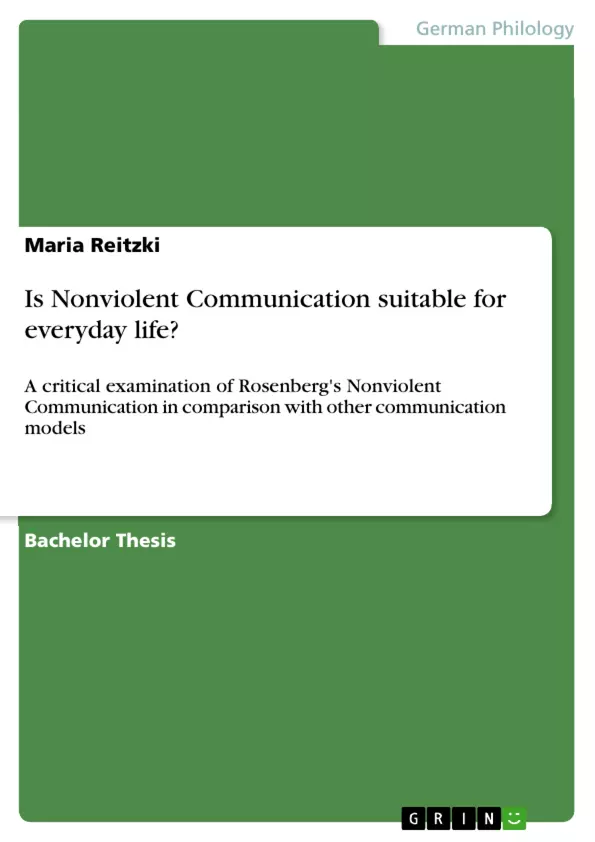Conflicts with our fellow human beings are always part of living together. In the meantime, there are many approaches to dealing with conflicts and overcoming differences. But so far there is none that has been able to establish itself as the only true theory. Could this claim possibly be made for Nonviolent communication? Is it a suitable approach to conflict management? According to Rosenberg, Nonviolent communication can be successfully applied in a wide variety of situations. He includes "close relationships, families, schools, organizations and institutions, therapy and counseling, diplomatic and business negotiations, disputes and conflicts of all kinds."
But is Nonviolent communication an approach that exists not only as a theory, but has its impact precisely where conflicts actually arise, in everyday interactions with others? And can Nonviolent communication also help people in their lives away from conflicts? These considerations have led to an overarching research question: Is Nonviolent Communication suitable for everyday life?
For a better understanding, the first part of the paper will first highlight in detail the basic assumptions of Nonviolent communication, how it came about and how it works, as well as its special features. Four other communication models will be used to further illustrate Nonviolent communication; this part of the paper will be its main focus. Elements from the work of Carl Rogers, Virginia Satir and Friedemann Schulz von Thun, as well as from the model of Neurolinguistic Programming (NLP), will show the extent to which Rosenberg was influenced by other models in the development of Nonviolent communication. On the basis of these models, which were chosen because of their familiarity and recognized success, the suitability of Nonviolent communication for everyday use will also be discussed.
Nonviolent communication will then be examined for dangers. This will be done on the one hand via the theory of cognitive dissonance, on the other hand the aspect of manipulation will be included.
Inhaltsverzeichnis (Table of Contents)
- Introduction.
- Nonviolent Communication according to Rosenberg.........
- The emergence of nonviolent communication..
- The basic model of nonviolent communication.
- The four components ....
- Empathy.......
- The meaning of the emotional vocabulary.
- The meaning of the symbols of wolf and giraffe.
- Influences on the method of nonviolent communication......
- Influencing Nonviolent Communication according to Rosenberg.
- Influencing Nonviolent Communication through other communication models..
- Similarities with Carl Rogers' work.........
- Similarities with Virginia Satir's work..\n
- Similarities with neurolinguistic programming.
- Similarities with the four-sided model by Friedemann Schulz von Thun......
- Interim conclusion........
- Dangers of Nonviolent Communication
- Festinger's theory of dissonance
- Transfer of dissonance theory on nonviolent communication........
- Strategies for dissonance reduction......
- The strategies for Rosenberg's four-component model..\n
- Nonviolent communication and manipulation
- Second interim conclusion.......
- Conclusion.
Zielsetzung und Themenschwerpunkte (Objectives and Key Themes)
The primary objective of this research is to investigate the suitability of nonviolent communication for everyday use, focusing exclusively on the original model developed by Marshall B. Rosenberg. This analysis explores the theoretical foundation of nonviolent communication, its historical development, and its practical applications. By comparing nonviolent communication with other communication models, the work aims to determine its unique features and assess its potential for achieving its stated goal of fostering relationships based on openness and compassion.
- The theoretical basis and origins of nonviolent communication
- Comparison of nonviolent communication with other communication models
- Assessment of the suitability of nonviolent communication for everyday life
- Examination of potential dangers associated with nonviolent communication, including dissonance and manipulation
- Critical evaluation of nonviolent communication, considering both its strengths and weaknesses.
Zusammenfassung der Kapitel (Chapter Summaries)
The initial chapters provide an overview of nonviolent communication, its historical background, and its core components. The author explores the development of the concept through the personal experiences of Dr. Marshall B. Rosenberg, outlining his motivation for promoting nonviolent communication and the core principles guiding its application. This section highlights the four components of nonviolent communication: observations, feelings, needs, and requests. The author also examines the concept of empathy within nonviolent communication and explores the significance of both emotional vocabulary and symbolic representations within the model.
Subsequent chapters analyze the influences on nonviolent communication, drawing comparisons with other prominent communication models. The work examines similarities between nonviolent communication and the theories of Carl Rogers, Virginia Satir, and Friedemann Schulz von Thun, as well as neurolinguistic programming (NLP). This comparative analysis highlights the potential strengths and weaknesses of nonviolent communication in comparison to other established communication methods. The author examines potential dangers associated with nonviolent communication, specifically addressing the theory of cognitive dissonance and its impact on the application of the model. Additionally, the author investigates the potential for manipulation within nonviolent communication, exploring the ethical considerations and implications of such practices.
Schlüsselwörter (Keywords)
The work centers on the concepts of nonviolent communication, conflict resolution, empathy, and communication models. It examines the applicability of nonviolent communication in everyday life, focusing on its potential benefits and drawbacks. The study explores the relationship between nonviolent communication and other prominent communication models, including those of Carl Rogers, Virginia Satir, and Friedemann Schulz von Thun, as well as neurolinguistic programming (NLP). The research also investigates the potential dangers of nonviolent communication, including cognitive dissonance and manipulation, and offers a critical evaluation of its overall effectiveness and suitability for everyday use.
- Citation du texte
- Maria Reitzki (Auteur), 2007, Is Nonviolent Communication suitable for everyday life?, Munich, GRIN Verlag, https://www.grin.com/document/1170833



